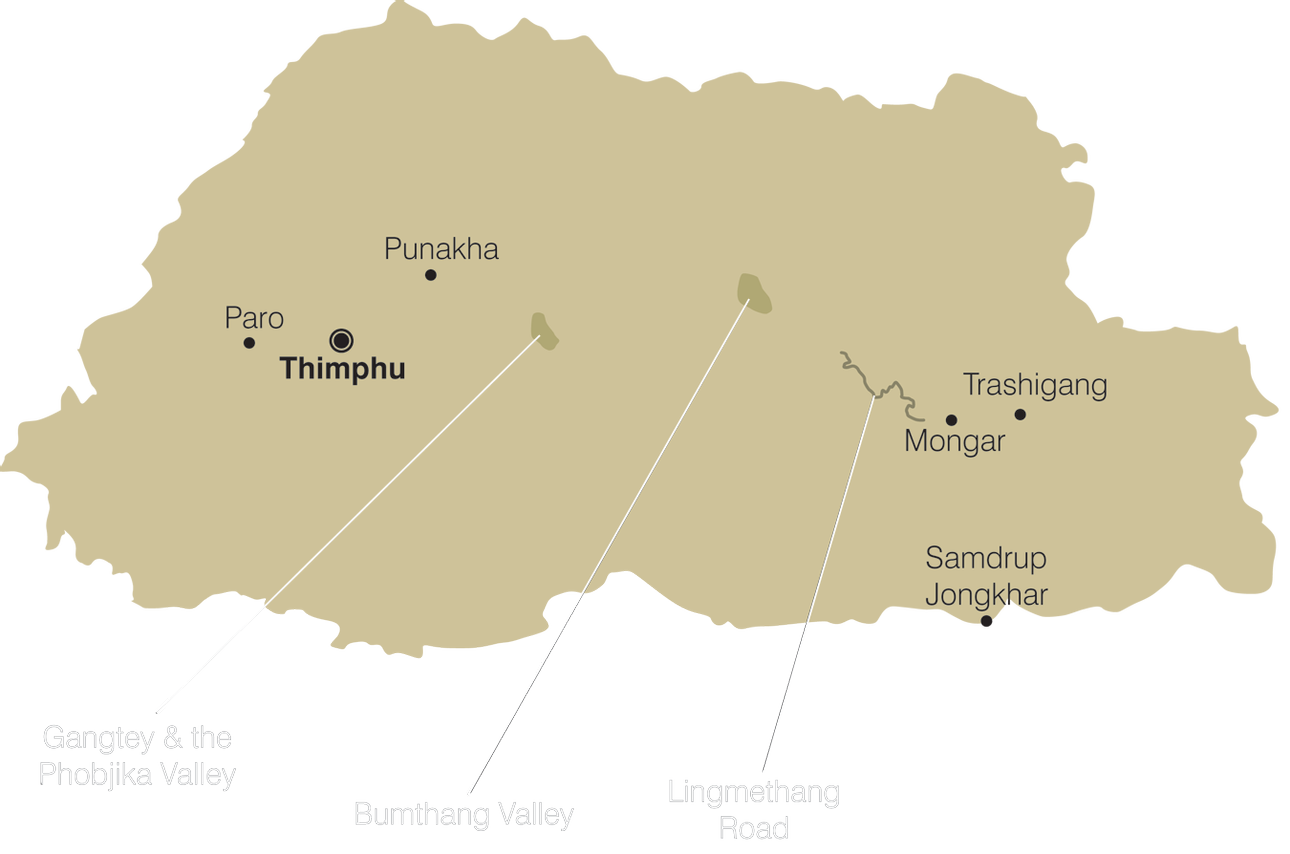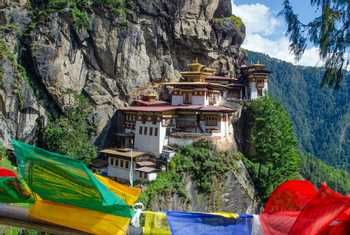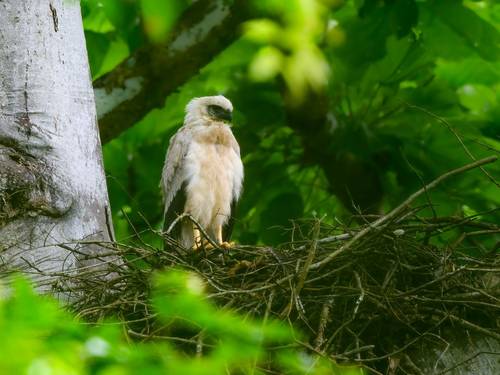


Location Highlights
- Paro – site of the famous Tiger’s Nest Monastery
- Thimphu – Bhutan’s capital has some interesting sites
- Punakha – this low-altitude valley offers excellent birding and Bhutan’s most beautiful dzong
- Gangtey & the Phobjika Valley – the wintering site of a flock of endangered Black-necked Cranes
- Bumthang Valley – a scenic location with good walks and the gateway to eastern Bhutan
- Lingmethang Road – a legendary birding site in the remote east of Bhutan


Tailormade Holidays in Bhutan
Tailormade | Tour Code: TBTNCreate your own Tailormade holiday to Bhutan with dates and an itinerary to suit you.
When to Visit
| J | F | M | A | M | J | J | A | S | O | N | D |
| Y | Y | YY | YY | YY | Y | - | - | Y | YY | YY | Y |
SAMPLE HOLIDAY: Bhutan - A Birding Odyssey
19 days from £7,495 (Flight Inclusive)
A comprehensive itinerary incorporating Bhutan's best birding locations, including the Lingmethang Road, as well as the country's key cultural sites. The itinerary also stops in the remote eastern Bhutanese settlements of Mongar and Trashigang.
Location Highlights
- Paro – site of the famous Tiger’s Nest Monastery
- Thimphu – Bhutan’s capital has some interesting sites
- Punakha – this low-altitude valley offers excellent birding and Bhutan’s most beautiful dzong
- Gangtey & the Phobjika Valley – the wintering site of a flock of endangered Black-necked Cranes
- Bumthang Valley – a scenic location with good walks and the gateway to eastern Bhutan
- Lingmethang Road – a legendary birding site in the remote east of Bhutan


Quick Enquiry
Summary
Bhutan – the ‘Land of the Thunder Dragon’ – is a remarkable country! Hemmed in by snowbound Himalayan giants to the north and India’s hectic mass of humanity to the south, few countries have better preserved their culture and their forests.
In spring Bhutan’s pristine primary forests are transformed to slopes of resplendent yellow, white, pink or red as the predominant rhododendron species of a hillside bursts into bloom. Little explored and little known, their fauna and flora is incredibly rich. Any keen birder or botanist will be in their element amongst the forests, which are filled with flowering trees, shrubs and colourful primulas. Remarkably, they are accessible directly from the road, but extend over hills and valleys for as far as the eye can see.
The forests harbour a wealth of avian specialities such as Satyr Tragopan, Himalayan Monal, Rufous-necked Hornbill, Yellow-rumped Honeyguide, Ward’s Trogon and Beautiful Nuthatch to name but a few! Mammal sightings are harder to come by, but can include monkeys such as Golden, Capped and Grey Langurs, plus Muntjac, Yellow-throated Marten and Orange-bellied Squirrel, or perhaps even a Leopard or Red Panda which have been seen by Naturetrek clients in the past!
A holiday in Bhutan also offers an insight into an intriguing and once inaccessible cultural landscape. Tibetan Buddhism is the predominant religion and the rhythms of local life are very much influenced by its principles. This is a land of huge fortified monasteries or ‘dzongs’, where maroon-clad monks and nuns mingle with traditionally dressed local ‘householders’ who softly whisper sacred mantras whilst going about their daily lives.
Our Destinations

The Bumthang Valley is actually a series of four valleys that lie at the heart of Bhutan. There are many beautiful walks in the area through the pine forests and grassy meadows that sit high on the slopes above the roaring Chamkar River. On such walks you will come across small shrines and Buddhist prayer wheels nestled in shady ravines and small rustic monasteries with friendly monks and nuns. The small settlement of Jakar comprises a cluster of houses, small shops and restaurants and a visit to the town’s Jambay Lhakhang monastery is recommended. The valley of Ura has an extremely rustic and rural feel and is worthy of a full day’s visit. Bumthang is also a good starting point for a number of excellent treks and it is the gateway to the little-visited eastern reaches of Bhutan.

The small town of Paro is often the first point of call for visitors to Bhutan, since the country’s international airport is located here. Paro holds many delights, not least the trail up to the famed Taktsang or Tiger’s Nest Monastery, which seemingly clings to a cliff-face and commands impressive views across the valley. This is a must for any holiday itinerary, and we advise an early start to make the most of the birdlife and flora along the forested trail that leads up to the monastery. Other worthwhile highlights in Paro include the National Museum, the imposing Paro Dzong or a full day excursion to the scenic Haa Valley, an excellent botanical and birding site where the sensational Himalayan Monal may be seen. The sought-after Ibisbill, the iconic wading bird of the Himalaya, is another avian attraction of the Paro area, where it favours the gravel islands of the Paro River.

Bhutan’s capital city isn’t a place in which most visitors linger long and a night here is generally enough to satisfy curiosity. The imposing Tashi Dzong is one of the highlights and there’s also a nearby nunnery worth visiting. For those interested, the Mothithang Takin Preserve holds several Takin, the bizarre goat-antelope that resembles a mountain Musk-ox and is Bhutan’s national animal.

The Punakha Valley is reached by crossing the Dochu La pass from Paro or Thimpu, a drive of only a few hours. As well as spectacular views of the Himalayan snowbound peaks, this journey offers excellent birding and botanising in the wonderful hemlock, fir, rhododendron and evergreen oak forests en route. Fire-tailed Myzornis and Mrs Gould’s Sunbird are among the most stunning forest birds to look for, while in spring the flowering rhododendrons and magnolias are a highlight. The Punakha Valley itself, lying at under 1,000 metres, is one of the lowest valleys in central Bhutan; it is consequently warmer and holds a range of lowland bird species that you are unlikely to see elsewhere in Bhutan. The fabulous Punakha Dzong is situated at the confluence of two rivers and is flanked by several Jacaranda trees which blossom in spring; it is widely considered to be the most beautiful of all the country’s dzongs. Many rewarding walks can be made from Punakha, exploring both the river and forest habitats, but it is the valley to the north of Punakha that holds the most special species, among them Fire-capped Tit and the extremely rare White-bellied Heron.

The little village of Gangtey consists of a few farmhouses scattered upon the hillside overlooking a large upland mire known as the Phobjika Valley. A large flock of Black-necked Cranes winters here, making this valley one of the most important wildlife reserves in the country. The cranes generally arrive towards the end of October and depart between mid-February and mid-March. These magnificent birds have become part of the local folklore here and hold a special place in the hearts of the residents of Gangtey, to the extent that an entire festival is held to celebrate their safe return each year, usually in November. There are lots of excellent walking trails around the valley and a visit here shouldn’t be discounted even if you’re coming at a time when the cranes are not in residence.

Located in the far east of Bhutan, the Lingmethang Road is only 79 kilometres long but passes through every forest type and altitudinal zone between its highest point at 3,700 metres all the way down to the valley bottom, a drop of over 3,000 metres! This extreme altitudinal range enables one to see an extraordinarily high number and diversity of bird species and these roadside forests hold many of the most sought-after of eastern Himalayan specialities, amongst them Ward’s Trogon, Satyr Tragopan and Rufous-necked Hornbill, plus a wealth of warblers and babblers at lower altitudes. Suffice it to say, the birding here is quite outstanding; however, this is a remote and little-visited location where camping is necessary and long road journeys are required. For the serious birder, though, it’s ‘a must’!

The Bhutanese enjoy many magnificent Buddhist festivals or ‘Tsechus’ throughout the year and most of these take place in the monasteries and dzongs around the country. Each one is a time for locals to come together to socialise and celebrate, wearing their finest national dress, and one can’t help but be swept up with the sense of excitement, fun and the deep reverence these people have for their Buddhist roots. These events are always colourful affairs, with the monks donning intricate costumes and ghoulish masks to perform ritualistic ‘Cham’ dances in the cloistered courtyards of the dzongs and monasteries. Specific festival dates change each year according to the lunar calendar and it is necessary to book early to include one of these dates in your itinerary as accommodation often sells out well in advance! Some of our favourite festivals include the Thimphu Tsechu (Sept/Oct), Jambay Lhakhang Drup of Bumthang (Oct/Nov), the Black-necked Crane Festival of Gangtey in November (the best for a wildlife theme!), the Punakha Tsechu (Feb/Mar) and the Paro Tsechu (Mar/Apr). We can help you decide on a particular festival, but whichever you attend it is bound to be a most memorable experience!

Bhutan offers some of the best trekking opportunities in the world, enabling you to explore and enjoy its Himalayan peaks, isolated valleys, magnificent temperate forests, mysterious Buddhist hermitages and spectacular wildlife that includes Tiger, Takin and Snow Leopard amongst its highest mountains. All treks are undertaken with a knowledgeable guide, a team of pack ponies or Yaks and a cook. Since there are no mountain lodges or tea houses it is necessary to stay overnight in tents which are often set up near small monasteries or shrines. A reasonable level of fitness is required as the routes traverse steep valleys, cross high passes, and are at altitude. However, there are many options available, from short low-altitude treks to longer, expedition-style adventures.

Bhutan works exceptionally well in combination with both India and/or Nepal, but whether you choose to do this, or focus solely on Bhutan, will depend on the time and budget you have available, as well as your ambitions with regard to the region’s wildlife and cultural attractions. Indian destinations that combine well with Bhutan include Kaziranga National Park in Assam, arguably India’s best wildlife reserve and the former British hill station of Darjeeling. Kathmandu presents another obvious option since many flights into Bhutan come via Nepal’s capital. Packed with UNESCO World Heritage Sites, and also offering Chitwan National Park, Pokhara (for mountain views), Koshi Tappu Wildlife Reserve and a wealth of trekking options, a stop-over in Nepal is hard to resist. With a combined experience of over 60 years of operating holidays to this part of the world, our team is well placed to offer advice and guidance to make sure that you get the most out of your visit!
Sample Itineraries
A comprehensive itinerary incorporating Bhutan's best birding locations, including the Lingmethang Road, as well as the country's key cultural sites. The itinerary also stops in the remote eastern Bhutanese settlements of Mongar and Trashigang.

Extend your holiday:
At the end of your holiday you may want to just relax in a comfortable hotel in Kolkata for a couple of nights, or you could head to a delightful tea planter's bungalow to relax. Kaziranga National Park, Manas National Park and the Sunderbans are amongst the exciting Indian wildlife destinations that can be included.
The Essentials
- Wildlife Guides: An excellent, English-speaking local naturalist/cultural or trekking guide will accompany you throughout your holiday in Bhutan. However, should you require an expert naturalist, ornithologist or botanist guide to accompany you, we will be pleased to arrange this.
- When to Visit: The weather in Bhutan is generally good between September and May, the period from mid-June to mid-September being the time of the monsoon. However, your exact dates will depend on your priorities. If birding or botany is high on your agenda then a visit in the spring months of March, April or May is advised, when the mountainsides are awash with colourful rhododendrons and bird activity is at its most frenzied. Happily, this is also the time of few tourists! For a more general holiday, that takes in Bhutan’s cultural sites as well as the scenery and wildlife, any time from mid-September to May is possible, although the winter months between December and February are cold (with snowfall) above 2,000 metres.
J F M A M J J A S O N D Y Y YY YY YY Y - - Y YY YY Y - Getting Around: Bhutan has one main road that runs from west to east. Unless you are trekking, this road forms the basis for all Bhutan itineraries. At either end, this road leads into India, meaning that itineraries which combine both countries are very practical, especially if you wish to explore Darjeeling and Assam (including Kaziranga).
Why Naturetrek Tailormade?
'A Naturetrek Tailormade holiday allows you, with the benefit of our wildlife travel expertise and destination experience, to enjoy the perfect private wildlife holiday – one that truly matches your requirements, expectations and ambitions. We will ensure the most competitive prices, superb naturalist guides and seamless ground services.
Some of the benefits of Naturetrek Tailormade travel include:
• A bespoke itinerary which is crafted by experts and designed specifically for you
• Private guiding by the very best local naturalists
• Travel with people you know, at your own pace
• Incorporate as much culture, history or relaxation time as you wish
• Choose dates to suit you
• Select your preferred style of accommodation
• Travel with families and children of any age
Furthermore, our Tailormade team are always on hand to help and guide you along the way, with friendly advice, first-hand knowledge and inside information specific to your destination of choice. So if you have any queries about your holiday, we will be delighted to answer them. Please just give us a call!'

Related articles
In this article we share special offers on holidays exploring Bhutan's pristine wilderness and captivating culture.
We now have three tour reports published for the 2023 'Just Jaguars' season, which showcases the magnificent wildlife of the Brazilian Pantanal!
In this article, tour leader Tom Brereton discusses the amazing pelagic wildlife that can be seen on our 'Seabirds & Cetaceans of Lyme Bay' day trip.
Our Website & Marketing Manager, Sara Frost, has recently returned from leading our wildlife cruise through the Falklands, South Georgia and Antarctica. In this article, she shares highlights from the trip of a lifetime!
In this article, Operations Manager, Alison Steel, provides a comprehensive guide to wildlife-watching on the Scottish Islands and what each of them has to offer.
Mick Durham is a Naturetrek tour leader who recently returned from our Antarctic wildlife cruise as a guest. Here, he shares the highlights of his experience as a photography enthusiast!
Tour leader, Daniel Green, outlines the superb selection of butterflies and dragonflies we can expect to see on this 6-day tour to Sweden, departing in June.
In March, Operations Manager, Matt Eade, joined a week-long tourism showcase event on the remote island Saint Helena. In this article, he shares his experiences from this remarkable island located 1,165 miles off the coast of Angola.
In June, Operations Assistant, Holly Wheeler, had the pleasure of joining a select group of travel specialists and journalists on a trip to Latvia. In this article, she shares her experiences.
Tailormade Consultant, George Vincent, reports on the exciting discovery of a new Crested Eagle nest deep in the Peruvian Jungle.
Naturetrek receives the 'Resilience' award at The Thames Valley SME Growth 100 Awards!
We are delighted to offer Naturetrek readers a 30% discount on A Field Guide to the Larger Mammals of South America by Richard Webb and Jeff Blincow.
Operations Manager, Barney Jones, has just returned from a trip to Madagascar. Read about his adventures and wildlife highlights here!
In this article, Operations Manager, Alison Steel, provides a comprehensive guide to wildlife-watching on the Scottish Islands and what each of them has to offer.
In this article, Operations Manager, Alison Steel, provides a comprehensive guide to wildlife-watching in the British Isles in the autumn and winter.
Tour leader, Sara Frost, features on Canadian podcast ‘Whale Tales’ after an incredibly rare encounter whilst guiding our Naturetrek cruise in Antarctica.
In recent months, four trail cameras have captured some exciting footage of the abundant mammals living in the Naturetrek Macchietelle Reserve.
Client John Highet shares the highlights from his 'Botswana's Desert & Delta' tour in September.
Similar Trips
Tailormade Holidays in Burma TAILORMADE | TOUR CODE : TBUR
- Jan
- Feb
- Mar
- Apr
- May
- Jun
- Jul
- Aug
- Sep
- Oct
- Nov
- Dec
Tailormade Holidays in Nepal TAILORMADE | TOUR CODE : TNPL
- Jan
- Feb
- Mar
- Apr
- May
- Jun
- Jul
- Aug
- Sep
- Oct
- Nov
- Dec
Video



 Loading search...
Loading search...





















































